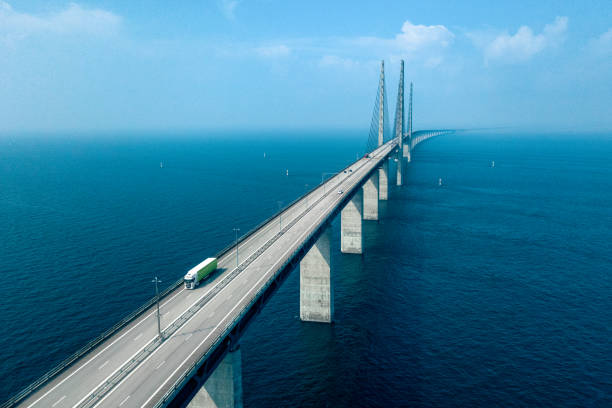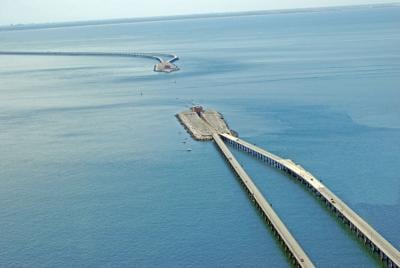
Discover the fascinating world of Underwater Bridge, exploring their innovative design, remarkable structures, and the engineering feats behind these modern marvels. Uncover how they revolutionize travel and connectivity.
Introduction
Underwater bridges represent an extraordinary fusion of engineering and design, showcasing humanity’s ability to conquer nature’s challenges. As marvels of modern engineering, these structures combine innovative design with practical functionality, creating pathways across vast bodies of water that seamlessly connect distant lands. These feats of engineering not only enhance connectivity but also symbolize the evolution of infrastructure and technological advancement.
The Evolution of Underwater Bridges
To understand the significance of underwater bridges, it’s essential to explore their historical development. From early bridge-building techniques to the sophisticated underwater constructions of today, the evolution of these structures reflects advances in materials, design principles, and construction methods. Historically, the challenge of crossing large bodies of water has inspired numerous innovative solutions, leading to the development of complex underwater bridges.
Øresund Bridge
The Øresund Bridge is a remarkable example of integrating a bridge with an underwater tunnel. Stretching approximately 12 kilometers, this iconic structure connects Denmark and Sweden, beginning as a bridge and transitioning into an underwater tunnel. The Øresund Bridge showcases how engineers can seamlessly blend different crossing methods to overcome geographical challenges and enhance regional connectivity.

Chesapeake Bay Bridge-Tunnel
Located in Virginia, USA, the Chesapeake Bay Bridge-Tunnel combines a bridge and underwater tunnel spanning 23 miles. This structure is notable for its impressive length and ability to handle heavy traffic and harsh weather conditions. The Chesapeake Bay Bridge-Tunnel exemplifies the ingenuity required to build an infrastructure capable of withstanding the elements and facilitating efficient transportation.

Submerged Floating Tunnel
The submerged floating tunnel represents an innovative approach to underwater crossings. Known as an Archimedes bridge, this design proposes a tunnel that floats in water and is supported by its buoyancy. While this concept remains a proposal rather than a completed project, it highlights the forward-thinking strategies used to address the challenges of underwater infrastructure.

Engineering Challenges
Building an underwater bridge involves overcoming numerous engineering challenges. These challenges include dealing with extreme water pressure, ensuring structural integrity, and managing environmental impacts. Engineers must employ advanced materials and techniques to address these issues and ensure the safety and longevity of the underwater bridge.
Construction Techniques
The construction of underwater bridges requires specialized techniques and equipment. From tunnel boring machines to underwater welding, the process involves a range of technologies designed to handle the unique conditions of underwater environments. Understanding these construction methods provides insight into the complexity and precision of building such structures.
Environmental Considerations
One critical aspect of building underwater bridges is managing their environmental impact. Engineers and environmentalists work together to ensure construction practices minimize disruption to aquatic ecosystems and maintain water quality. This balance between development and conservation is essential for the sustainable success of underwater bridge projects.
Notable Underwater Bridges Around the World
Examining notable underwater bridges worldwide provides valuable insights into their design and construction. Case studies of structures like the Øresund Bridge, Chesapeake Bay Bridge Tunnel, and proposed submerged floating tunnels highlight the diversity and ingenuity of underwater bridge engineering. These case studies offer a comprehensive look at how different regions tackle the challenges of underwater crossings.

The Benefits of Underwater Bridges
Underwater bridges offer significant economic benefits by improving transportation efficiency and fostering regional development. These structures enhance connectivity between regions, facilitate trade, and support tourism. Understanding the financial impact of underwater bridges helps to appreciate their value beyond engineering achievements.
Symbolism and Identity
Underwater bridges often hold cultural and symbolic significance for the regions they connect. They represent progress, innovation, and the ability to overcome natural barriers. The cultural importance of these structures extends beyond their practical functions, reflecting the values and aspirations of the communities they serve.
Maintenance and Upkeep
Maintaining underwater bridges is crucial for ensuring their long-term functionality and safety. Regular inspections, repairs, and upgrades are necessary to address wear and tear caused by environmental conditions and traffic. Effective maintenance strategies help prolong these structures’ lifespan and uphold their operational efficiency.
Public Perception
The public perception of underwater bridges can influence their acceptance and use. Positive perceptions of these structures can lead to increased support for infrastructure projects and greater public appreciation for engineering achievements. Understanding how communities view underwater bridges provides insights into their role in regional development.

Enhancing Underwater Bridge Design
Advancements in technology continue to shape the design and construction of underwater bridges. Innovations such as advanced simulation tools, improved materials, and automated construction techniques contribute to more efficient and effective bridge projects. Exploring these technological advancements reveals how they drive progress in underwater bridge engineering.
Global Efforts in Underwater Bridge Projects
International collaboration plays a vital role in the development of underwater bridges. Engineers, designers, and researchers worldwide work together to share knowledge, resources, and expertise. Collaborative efforts contribute to the successful implementation of complex underwater bridge projects and foster innovation on a global scale.
Ensuring Structural Integrity
Ensuring the safety of underwater bridges involves implementing rigorous safety measures and protocols. From designing for extreme conditions to conducting thorough inspections, engineers prioritize structural integrity to protect users and maintain the reliability of these critical infrastructures. Safety measures are essential for the continued success and public trust in underwater bridges.
Governing Underwater Bridge Construction
Regulations and standards govern the construction and maintenance of underwater bridges. Adhering to these regulations ensures that projects meet safety, environmental, and quality requirements. Understanding the role of rules provides insight into the regulatory framework that supports the successful implementation of underwater bridge projects.

Learning from Underwater Bridge Projects
Underwater bridge projects offer valuable educational opportunities for students and professionals in engineering and related fields. Studying these projects provides insights into advanced construction techniques, problem-solving strategies, and the integration of different engineering disciplines. Educational programs focusing on underwater bridge engineering contribute to the development of future experts in the field.
The People Behind the Projects
The stories of individuals involved in underwater bridge projects are often inspirational. Engineers, designers, and construction workers contribute their expertise and dedication to overcoming complex challenges. Highlighting these personal stories provides a deeper appreciation for the human effort and creativity in building underwater bridges.
Underwater Bridges vs. Traditional Bridges
Comparing underwater bridges with traditional bridges offers insights into their respective advantages and challenges. While traditional bridges are designed to span over land or water, underwater bridges address unique challenges related to submersion and pressure. Understanding these differences helps to appreciate each type of bridge’s specific benefits and limitations.
Conclusion
Underwater Bridge are remarkable engineering achievements demonstrating human ingenuity and perseverance. These structures enhance connectivity and symbolize the ongoing evolution of infrastructure. Celebrating the successes and advancements in underwater bridge engineering highlights the potential for future innovations and the continued impact of these extraordinary feats.
Read Also: Exploring the Magic of 3-Day Disney Pass $99
